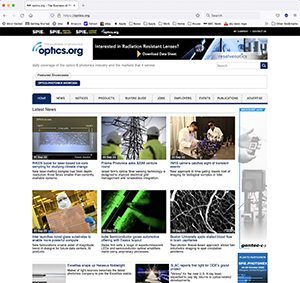In this issue of Industrial Process News, we are honoured to select optics.org as our Photonics Publication Company of the Month.
 In 1960 physicist and engineer, Theodore (Ted) Maiman successfully carried out the first ruby laser demonstration, followed by the subsequent development of the gallium arsenide (GaAs) semiconductor laser diode in 1962. These two inventions ignited the world of photonics, propelling fiber-optic communication decades later in the 1980’s. Nowadays, photonics is defined as the physical science of light waves: namely the formation, detection and manipulation of light.
In 1960 physicist and engineer, Theodore (Ted) Maiman successfully carried out the first ruby laser demonstration, followed by the subsequent development of the gallium arsenide (GaAs) semiconductor laser diode in 1962. These two inventions ignited the world of photonics, propelling fiber-optic communication decades later in the 1980’s. Nowadays, photonics is defined as the physical science of light waves: namely the formation, detection and manipulation of light.
Photonics is a huge, growth industry from the advance of fiber-optic networks powering ultrafast broadband, the versality of LED lighting solutions, medical state lasers, lightweight, light sensors in bar code scanners and automotive sensors, to next-generational, optoelectronic circuits.
![]() optics.org is a renowned online resource, offering all the latest informative articles and business news from the photonics industry. With a global readership, spanning North America, Asia and Europe, it is the most trusted publication for scientists, engineers, through to sales directors in the world of photonics. It is published in conjunction with SPIE: The International Society for Optics and Photonics, a leading not-for-profit organisation. SPIE was founded in 1955, with a leading mission to connect the global optics and photonics community towards a further advancement of research and technologies. Over the past five years, the organisation has contributed more than $22 million to the international optics community, in the form of education and training grants.
optics.org is a renowned online resource, offering all the latest informative articles and business news from the photonics industry. With a global readership, spanning North America, Asia and Europe, it is the most trusted publication for scientists, engineers, through to sales directors in the world of photonics. It is published in conjunction with SPIE: The International Society for Optics and Photonics, a leading not-for-profit organisation. SPIE was founded in 1955, with a leading mission to connect the global optics and photonics community towards a further advancement of research and technologies. Over the past five years, the organisation has contributed more than $22 million to the international optics community, in the form of education and training grants.

optics.org was launched in 1996 and now boasts 30,000 monthly users and 20,000+ subscribers to its weekly e-newsletter, from all over the world. With over 1.1 million page views per year, the publication is the undisputed leading online resource, from across the world of photonics. We spoke to Head of Sales & Marketing: Rob Fisher to find out more.
He commented, “optics.org is a daily resource, providing informative content, news articles, analysis, case studies and press releases. We cover all the latest topics including: cutting-edge cancer detection sensors, industrial and defence applications, automotive sensors, virtual reality through to quantum photonics. SPIE is a not-for-profit organisation, unlike most commercial profit-driven organisations, so we are focused on the dissemination of factually-based content, which proves indispensable for many working in the field.”
 “We have a huge readership in North America, which provides major photonics investment, followed by the UK/Europe – with Germany providing manufacturing and the UK leading on quantum photonics, through to about 20% of our readership from Asia: providing industrial lasers and components/systems.”
“We have a huge readership in North America, which provides major photonics investment, followed by the UK/Europe – with Germany providing manufacturing and the UK leading on quantum photonics, through to about 20% of our readership from Asia: providing industrial lasers and components/systems.”
“Our writers are based in the UK, Europe and the US and we pride ourselves on publishing time-sensitive articles, pertinent to manufactures, R&D facilities and academic departments around the world.”
“We are looking forward to welcoming delegates to our SPIE Photonex 2023 in October in Glasgow, Scotland, this year, the largest exhibition in the UK that focuses on optics and photonics.”
SPIE Photonex 2023 runs from 25th-26th October at the SEC, Glasgow. The exhibition brings together the best solutions across components, instruments, systems providers, unifying the whole supply chain from supplier companies, consultants, industrial users, researchers, science groups and innovative starts-ups.

Leading exhibitors will be showcasing innovative products and research around the following areas:
- Applied photonic equipment
- Components and instrumentation
- Expertise and consultancy services
- Fibre optics
- Imaging
- Lasers and laser systems
- Materials
- Opto-mechanical devices and equipment
- Quantum technologies
- Sensors and detectors
- Spectroscopy
- Vacuum components and instruments
- Vacuum deposition systems
- Vacuum equipment and chambers
 Here at Industrial Process News, we have chosen to exclusively highlight three exhibitors at SPIE Photonex 2023:
Here at Industrial Process News, we have chosen to exclusively highlight three exhibitors at SPIE Photonex 2023:
- ALRAD: Extensive imaging portfolio range from ultraviolet, visible, infrared, shortwave infrared thermal wavelengths. The company supplies state-of-the-art scientific camera technology and vision components: optics, acquisition and illumination products. Bespoke software and integrated system solutions for applications including: machine vision, scientific, medical, agriculture, UAV/Drone and security sectors.
- ANDOR: Renowned leader in scientific imaging cameras, spectroscopy solutions and microscopy systems for research and OEM markets. Has been expertly providing next-generational light measuring solutions for over 20 years.
- Greateyes GmbH: Market-leading manufacturer of cooled, advanced-precision cameras covering spectroscopy, imaging, microscopy and astronomy and optical inspection systems. The cameras are used for a wide range of applications.
Fisher continued, “SPIE Photonex 2023 has been running for over 20 years, SPIE took on the management of the event three years ago, which is free to attend. We have exhibitors from across Europe including, Germany, France and Lithuania, as well as many from the UK and further afield including Turkey and the USA. Scotland is an ideal host as it is one of the centres of excellence for quantum photonics, with The University of Strathclyde leading the charge, alongside other exciting work in space communications and silicon photonics.”
 “With an industry programme that allows the public to hear how various government-funded projects are using photonics – from quantum to sustainable energy solutions to space, photonics impacts our lives at the smallest scale to the explorations of the expansive outer space.”
“With an industry programme that allows the public to hear how various government-funded projects are using photonics – from quantum to sustainable energy solutions to space, photonics impacts our lives at the smallest scale to the explorations of the expansive outer space.”
“Quantum photonics is now established as a hot topic in cyber-security and the UK Government is at the forefront, providing funding for R&D,” explained Rob.
To register for SPIE Photonex 2023, click here:
https://spie.org/conferences-and-exhibitions/photonex?webSyncID=aab06a42-b3ea-4363-65b6-2cbe51a80174&sessionGUID=a45e290d-e793-c15a-9dae-7e247254d54a&SSO=1
Quantum photonics uses quantum optics in applications such as: communications, computing and information processing. There is particular current interest in quantum cryptography: the art of securing and transmitting data that cannot be hacked. However, quantum cryptography uses physics, instead of the more traditional mathematics; using photons to transmit data using fiber optic communication. These great strides in photonics are set to revolutionise banking security, protect Government intelligence files, and protect websites.
“Scientists are closing-in on the science of quantum photonics and the UK The SPIE Photonex 2023 expo will feature the latest work in this area for interested parties across cyber-security,” added Fisher.
 The SPIE Photonex 2023 is an unmissable event for researchers from the photonics industry across UK, Ireland and Europe and has a rotating event location, with next year’s being hosted in Manchester.
The SPIE Photonex 2023 is an unmissable event for researchers from the photonics industry across UK, Ireland and Europe and has a rotating event location, with next year’s being hosted in Manchester.
SPIE Photonics West 2024 is the premiere event of the photonics calendar and will next run from 27th January-1st February at The Moscone Centre, San Francisco, USA. The focus will be on: lasers, biomedical, optics, biophotonic technology, quantum and optoelectronics, and draws major interest from the whole North American supply chain.
optics.org publishes news articles on a daily basis, with the opportunity for companies to publish their own press releases and product launches through a moderated channel. Recent cutting-edge articles have focused on breakthroughs by the University of Birmingham and University of Cambridge in using quantum methods to detect infrared light at room temperature. This is a huge step in understanding chemical and biological molecules. The research teams converted MIR protons into high-energy visible protons using molecular emitters. This could in the future help scientists identify MIR radiation and ultimately, perform spectroscopy at single-molecule level at room temperature.
This pioneering approach, called MIR Vibrationally-Assisted Luminescence (MIRAL) uses molecules that are MIR and contain visible light and could be applied to gas sensing, medical diagnosis, astronomical surveys and quantum communication.
The world has come a long way from the pioneering work of ruby lasers and semiconductor laser diodes of the 1960’s. The optical semiconductor developer Lumotive recently launched the Light Control Metasurface (LCM) optical beam-steering semiconductor. The LM10 is a powerhouse, supercharging the next-generation of programmable optics. The unique metamaterials and semiconductor manufacturing process provide cutting-edge 3D sensing for robotics, smart systems and automotive applications. optics.org exclusively published a fascinating article on the LM10, proving that solid-state beam steering technology is indeed the future of 3D sensing.
To sign-up to the optics.org weekly e-newsletter, click here:
https://optics.org/newsletter
For further editorial information, contact Matthew Peach:
matthew.peach@optics.org
For all sales enquiries, contact Rob Fisher:
rob.fisher@optics.org
For all further information on optics.org, see the website below:
https://optics.org
SPIE Photonex 2023 runs from 25th-26th October 2023 at the SEC, Glasgow.

